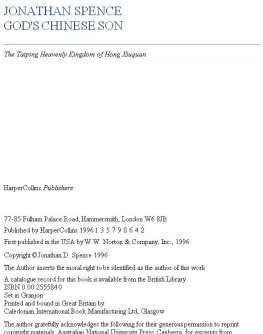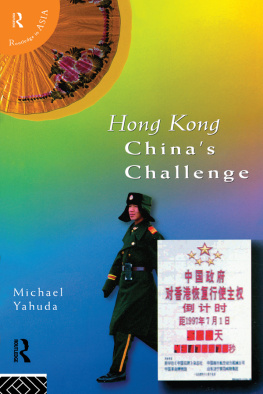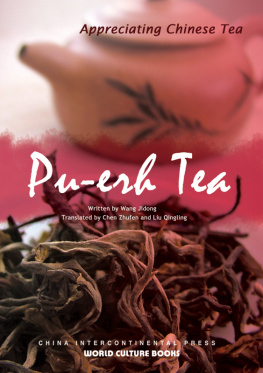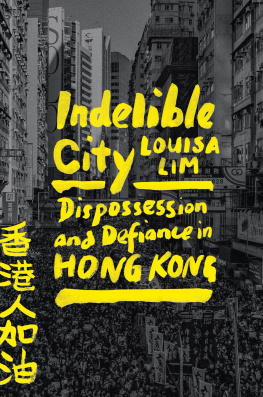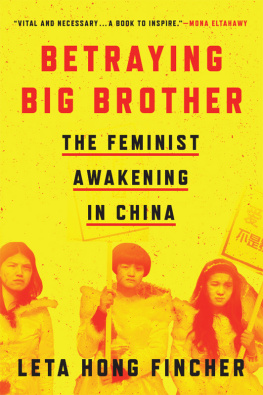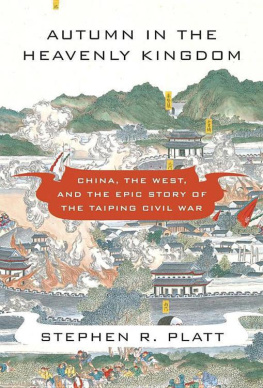JONATHAN SPENCE
GOD'S CHINESE SON
The Taiping Heavenly Kingdom of Hong Xiuquan
HarperCollins Publishers
77-85 Fulham Palace Road, Hammersmith, London W6 8JB
Published by HarperCollins 1996 135798642
First published in the USA by W.W. Norton & Company, Inc., 1996
Copyright Jonathan D. Spence 1996
The Author asserts the moral right to be identified as the author of this work
A catalogue record for this book is available from the British Library
ISBN 0 00 255584
Set in Granjon
Printed and bound in Great Britain by
Caledonian International Book Manufacturing Ltd, Glasgow
The author gratefully acknowledges the following for their generous permission to reprint copyright materials: Australian National University Press, Canberra, for excerpts from Prescott Clarke and J.S. Gregory, Western Reports on the Taiping: A Selection of Documents (1982), permission applied for; Cambridge University Press for excerpts from C.A. Curwen, Taiping Rebel: The Deposition of Li Hsiu-ch'eng (1977); Stanford University Press for an excerpt from Dian Murray and Quin Baoqi, The Origins of the Tiandihui (1994); University of Washington Press for excerpts from The Taiping Rebellion: History and Documents , volumes 2 and 3, by Franz Michael, in collaboration with Chung-li Chang (1971); and Yale University Press for excerpts from Jen Yu-wen, The Taiping Revolutionary Movement (1973), and from Norman Cohn, Cosmos, Chaos, and the World to Come: The Ancient Roots of Apocalyptic Faith (1 993).
All rights reserved. No part of this publication may be reproduced, stored in a retrieval system, or transmitted, in any form or by any means, electronic, mechanical, photocopying, recording or otherwise, without the prior permission of the publishers.
For Chin Annping, and to the memory of Chin Yu-fu
. .. and there shall be Beautiful things made new, for the surprise Of the sky-children.
John Keats, "Hyperion"
endpapers
Hong Xiuquan's hand-written response to Joseph Edkins.
This only surviving example of Hong Xiuquan's theological thinking in his own handwriting dates from the spring of 1861. The writing in black ink is by the Rev. Joseph Edkins, who visited Nanjing at that time, and constitutes an argument for the incorporeality of God. Edkins argues that all references to God's form, as they can be found in John's Gospel, the epistle to Timothy, the Book of Revelation, Isaiah, and Exodus, must not be taken literally but must all be read as figurative (yu).
Hong's comments are written across the same sheets in red ink. His displeasure can be seen at the very start, as he scores out Edkins' title and suggests his own version. In the seventh line of the essay, seven characters down, Hong erases the reference to Jesus being God's "only" son, and substitutes the word for "elder brother" (xiong). If Jesus were God's only son, then clearly Hong could not be Jesus' younger brother, and the change takes care of that. In the middle of line twelve, Hong erases the word "figurative" (yu) in relation to God's form, and writes in the word for "real" (shi). He makes the same change at the top of lines thirteen and sixteen. The heavy red scoring in the middle of the essay shows Hong's displeasure with Edkins' reading of Revelation.
At the end of Edkins' essay (see back endpaper) Hong scores out the last line which reaffirms the incorporeality of God, and writes out a poem of his own to clarify his theological points to Edkins. (The poem is translated below, p. 289.) On the back of the sheet on which he wrote the poem can be seen the imprint, also in red, of the massive Taiping state seal. Some of this red ink has bled through the paper and marked the top center of the poem. The scattered blobs of red ink across the poem reflect, perhaps, the agitation of the Heavenly King as he wrote out his response.
This document is printed here by courtesy of the British Library, Oriental and India Office Collections.
Contents
| WALLS ..............................................................................
| THE WORD .............................................................
| HOME GROUND ...........................................................
| SKY WAR ................................................................
| THE KEY .................................................................
| THE BASE ...............................................................
1 0 | EARTH WAR ..................................................................
1 1 | THE FIRST CITY ............................................................
1 2 | THE HUNT ......................................................................
13 | THE EARTHLY PARADISE ..........................................
1 4 | THREE SHIPS .................................................................
| THE SPLIT ........................................................................
1 6 | THE KILLING ................................................................
1 7 I FAMILY CIRCLES ........................................................
1 8 | THE WRONG MAN....................................................... 262
| NEW WORLDS .........................................................
| PRIEST-KING ...............................................................
2 1 [ SNOWFALL ..............................................................
2 2 | PARTINGS ......................................................................
Notes ........................................................................................
Index ........................................................................................
List of Illustrations
Endpapers
Letter of the British missionary Joseph Edkins, "covered with vermilion corrections" from Hong Xiuquan Frontispiece The Taiping seal Pages'10-11
Foreign Factory Site at Canton The American Factory in Canton Karl Gutzlaff Pages 40-41
Images from the Jade Record : The Sixth Layer of Hell "Life-is-short" "Death-has-gradations"
Page 175: A Taiping household registration document Pages 212-15
Scenes from the retreat and defeat of the Taiping Northern Expeditionary Forces, 1853-1855
Page 281: Images from Hong Xiuquan's 1853 edition of Pilgrim's Progress Page 313: The Ever-Victorious Army Pages 318-21
"Pacify the Southern Bandits": Qing paintings depicting their victories over the Taiping
List of Maps
Canton and the Foreign Settlement in the 1830s, page 6 Hong's Home Ground, page 27 Hong's First Journey, 1844 ,page 70
Areas of God-worshipers' Control, Guangxi, 1846-1850, page 112
The Battle of Jintian, 1851, page 131
From Yongan to Nanjing,
Nanjing, the Heavenly Capital, 1853-1864, page 187
Greatest Extent of Taiping Control, page 217
Shanghai in the 1860s ,page 301
The Flight and Capture of the Loyal King, the
Shield King, and the Young Monarch, 1864, page 327
Acknowledgments
In my struggle to understand the multileveled worlds of Hong Xiuquan, I have been helped by many friends and scholars. They need feel no responsibility for the way this book is shaped, nor for the errors of fact or fancy that it may contain, but I trust they will accept my gratitude. During two visits I made to Beijing in 1991 and 1993, and subsequently on his own visits to the United States, Wang Qingcheng was a particularly generous guide, sharing his own voluminous Taiping works, answering my endless questions, and introducing me to his former dissertation student Xia Chuntao, whose own knowledge and generosity thenceforth were equally boundless. It was thanks to Wang Qingcheng also that my wife, Chin Annping, and I were able to meet several of her grandfather Chin Yu-fu's former colleagues and students, giving us a sense of the powerful impressions that great scholar left behind him. Wang also introduced me to another leading Taiping scholar, Zhong Wendian, who looked after me in Guilin, and taught me much of the Hakka point of view. It was Zhong Wendian who in turn eased my route toward Guiping, and introduced me to my Jintian guide Huang Weilin. And it was thanks to Huang that for the first (and last) time I was able to sample the odorous Guiping lizard wine, and in his company in the mud and sultry heat of a Guangxi summer day that I saw the ribbon waterfalls flickering through the dense foliage in the foothills of Thistle Mountain. In Nanjing, it was Mao Jiaqi and Zhu Qingbao who served as my guiding spirits as I searched in the sprawling, smog-filled, broiling Yangzi city for echoes of the vanished New Jerusalem. And as if to round off all those quests, it was Willie Ruff in his flame-red Porsche who blared me into Shelbyville, Tennessee, on another summer's day, to show me where the Baptist preacher Issachar Jacox Roberts stretched his spiritual muscles in the 1830s, before he heeded the call to China, and received his chance to teach the Bible to the future Taiping Heavenly King.

